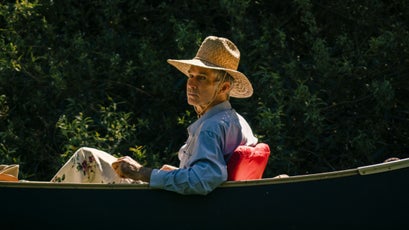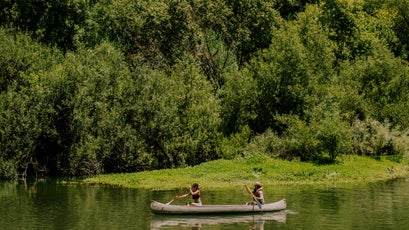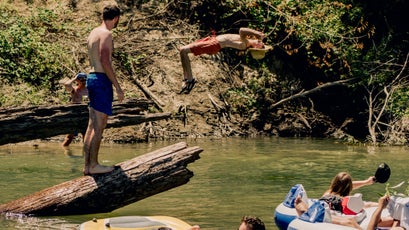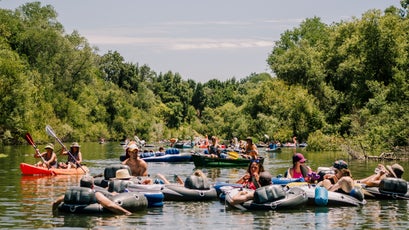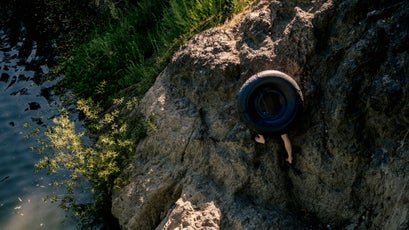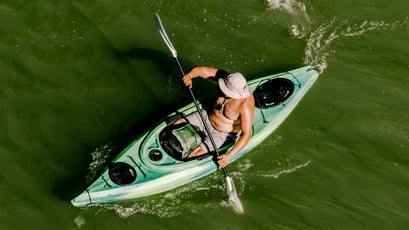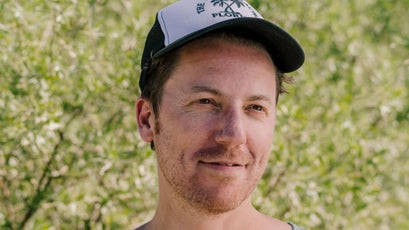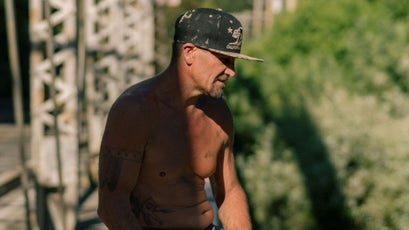Drawing a Line in the Sand Over River Rights
A four-year battle over a tiny patch of river beach in Northern California—between two middle-aged guys with way too much time on their hands—illustrates the deep divide in how we perceive access rights to public lands
Heading out the door? Read this article on the Outside app available now on iOS devices for members! Download the app.
This is a classic story of greed, nature, fear, change, large dogs, and violent golfing, but I didn’t know that when it began. Nor did I know that I’d get sucked into the thing myself. All I knew was John Harreld walking to the water’s edge on a summer morning in 2015 in Guerneville, California.
For neighbors in Harreld’s quiet river community, 90 minutes northwest of San Francisco, the image of the then 43-year-old starting his day in the sand had become a regular, if provocative, sight. Several times a week, he’d plant himself in a folding chair overlooking a gentle bend in the mellow Russian River. Sometimes a buddy joined him; other times he sat alone. The job was simple: Enjoy the beach. Sip coffee. Maybe spot an otter slithering up the lazy current. Most of all, do these things in clear view of the camera hidden in the trees.
The man who’d hung the camera believed that Harreld was trespassing. Harreld believed he was reclaiming land that belonged to the people. On a literal level, that’s all the two were fighting about: just 20 feet of gravelly beach.
Download the Audm app for your iPhone to listen to more longform titles.
But at the heart of the fight swirled bigger and fundamentally contradictory ideas. Remarkably basic questions about America itself were woven through their dispute. There would be no bloodshed—the same could not be said elsewhere—but the level of fury would nevertheless become shocking for the once friendly neighbors.
Harreld and his wife, Judith, live in a one-story home a short stroll from the river, with sunflowers and a tomato garden out front. He’s slim and youthful, with crinkly Paul Rudd eyes and a jovial, laid-back air. When he’s not working as a medical device analyst, he tends to be diving, rock climbing, investigating shipwrecks, or showing elaborate Lego creations he made in his home’s dedicated Lego studio. He’s a detail guy. One of these creations is a scale model of Chichén Itzá so meticulously accurate that when you shine a flashlight on the balustrade, it mimics the equinox effect at the actual temple.

On this June day, as he walked down the dirt path to the beach for morning sentry duty, he was pursuing his newest hobby: being the Rosa Parks of obscure riparian law.
Fifty yards or so above this quiet stretch of the river is a vacation home owned by Mark O’Flynn, a lawyer from San Francisco. Nearly four years ago, O’Flynn posted his first NO TRESPASSING sign. Like many property owners, he had come to equate public access with broken glass, poop in the bushes, and bad music blaring from drunk strangers’ speakers.
The problem, as Harreld saw it: the sign stood in flagrant violation of federal law. As he would explain to anyone who’d listen, the beach was subject to a public easement below a line called the ordinary high-water mark—a calculation roughly analogous to the average high tide. In 1981, the U.S. Supreme Court confirmed in Montana v. United States that this easement trumps private ownership in navigable rivers.
As he walked down the dirt path to the beach for morning sentry duty, he was pursuing his newest hobby: being the Rosa Parks of obscure riparian law.
Navigability, in turn, is established by proving that the river has qualified as a “highway of commerce,” used by ferries carrying tourists, say, or loggers floating felled trees downstream, both of which happened on the Russian River.
In other words, Harreld believed, that gravelly beach was everyone’s to enjoy, regardless of what signs were posted.
Harreld had known O’Flynn socially. His house is a minute’s walk away, and Harreld and his wife had been over for dinner. When he saw the sign, he e-mailed Mark to ask if it was his. Indeed, Mark replied.
There would be no more neighborly meals. Over the years that followed, a full-on cold war blossomed. Someone would run a shin-high line of wire across the path. One of Harreld’s allies would remove it. O’Flynn would hang cameras in the trees. Someone would paint over the latest NO TRESPASSING sign.
And now, on this Thursday morning in 2015, Harreld and some friends approached the beach only to find the path blocked by “cut bamboo, tree branches and matts of algae,” according to the June 18 entry in a detailed journal he’s been keeping since the conflict started. The next day, the group began removing the makeshift barricade, and O’Flynn ran out of his house.
What ensued borders on slapstick, with O’Flynn, according to Harreld, “pulling the bamboo out of my hands, then dashing over to pull some out of my friend’s hands, then dashing back to me.” (I don’t have O’Flynn’s account; he won’t discuss the dispute in detail.) Soon two sheriff’s deputies arrived, but they declined to take action.
Perhaps at this point you’re marveling at the amount of free time that middle-aged white men have. I marveled, too. But as I got deeper into the dispute, I came to see that this picayune squabble wasn’t all that it seemed. Behind the folly of turf wars and the arcana of river law, a larger conflict was playing out, one rooted in a profound disagreement over how we think about nature and how we divide it.
All over the country, that disagreement has become a feature of the landscape. I wanted to see it up close—and to see what happens when someone tries shifting the status quo in a small way. Like many rivers around the country, the Russian is full of vacation homes and resorts claiming private beaches, ordinary high-water mark be damned. It seemed some civil disobedience was in order—or, rather, civil obedience, if John Harreld was correct. So I gathered together three friends and some boats.
“How do property owners feel about boaters landing on the beaches in front of their land?” I asked the woman at the canoe-rental place in Forestville, the next town over from Guerneville. It was June 2017, the beginning of the season for her operation.
She cocked her head kindly, the way you do when talking to an idiot.
“There’s mucho public beaches to enjoy,” she said. “I imagine canoeists wouldn’t want to go up on anyone’s private beach, would they?”
Au contraire. Remember “The Swimmer,” that John Cheever short story where the lush decides to swim his way across all the pools in his county? That was my plan, except that instead of swimming pools, I would hit as many putatively private beaches along the Russian River as possible—first on a ten-mile stretch with my buddies, then on another four miles or so during a handful of smaller excursions. Instead of whiskey, we’d be fueled by a cocktail of righteousness and florid legalese.
“Public ownership of physically navigable rivers, including the land up to the ordinary high-water mark, pre-dates property deeds. What the property deed says or doesn’t say about the river is irrelevant.” So reads a river-law primer on the National Organization for Rivers website. And as the Supreme Court ruled, private ownership of the beds and banks of navigable rivers is “always subject to the public right of navigation.”
My friends and I paddled into the gentle current to see if that felt true.
The modest little towns of the Russian River Valley—Forestville, Rio Nido, Guerneville, Monte Rio—are wonderful and complex places, tight-knit blue-collar communities that mix unevenly with Bay Area weekenders. There’s an artsy scene and a gay scene and an ex-hippie scene and a homeless scene.
On the water, meanwhile, it’s pure Platonic river. From the languid sway of the bay laurel trees to the disco shimmer of the quaking aspens to the Dude-like serenity of the redwoods, a vague drugginess wafts over the place. The water beckons all types. One minute you’re chatting with a binocular-toting naturalist, the next with occupants of a 12-person raft built to look like a giant pizza. It’s a communal vibe, which makes the idea of an exclusive riverbank all the more jarring.
PRIVATE BEACH NO CANOES, a sign read. Yes canoes, we decided.
My friends and I spent the first hour pulling up on every no-trespassing beach we could find, though knowing we were within our rights didn’t make it less awkward. Imagine learning that punching someone in the face was actually legal—it would still be sort of tough to feel OK about it. But not a soul came running out to scowl at us. “Maybe nobody will say anything to you. It’d be totally different if you were black or brown and sidled up on someone’s property,” an African American friend had pointed out before the trip.
But by hour two, everything began to change. A broad gravel bar opened out into the river, cordoned off behind a length of rope and some buoys. PRIVATE BEACH NO CANOES, a sign read. Yes canoes, we decided. Three minutes later we were enjoying a fine game of bocce. Ten minutes after that came the first bellow.
A shirtless man in his sixties or seventies was standing on his deck 100 yards or so up from the river. He had a pair of binoculars trained on us and was yelling something I couldn’t quite hear.
“What?” I called.
“I said read the fucking sign in front of you!”
He was deeply tanned, with a leathery chest and long, thinning hair. He proceeded to unload. He was sick of people from God-knows-where marching all over his private oasis. As he yelled—now on the lawn in front of me—I did my best to politely represent the law. It bounced off. “How would you feel if I hung out in your fucking backyard?” he asked.
“There isn’t an easement on my backyard.”
He waved his hand. “If someone breaks their leg on this beach, I’m liable,” he said. I told him this wasn’t so—the state is liable, per the public easement.
“You don’t get it,” he replied. “I pay taxes on this beach.”
“Everyone does,” I said gently.
It went on like this. I thought that if we could just keep talking, we’d find some common ground, even if we never agreed that his ground was common. He thought otherwise and told me to fuck off again before ultimately walking away.
Over the next few hours, at a dozen ostensibly private beaches, my friends and I would encounter better and worse. At one beach, a friendly young couple lolled on a pair of inner tubes a few feet from shore. They were renters in a small community that claimed this particular beach as its own, but as far as they were concerned, anyone could use it if they cleaned up their mess. Half a mile away, we ran into a group at another beach that had been claimed by a community association, the Odd Fellows Recreation Club. “Your law is wrong,” one woman said when I explained my position. At another private club, a woman shook her head and told me, “It’s always been this way and always will be.”
Throughout my journey, I heard a common refrain from homeowners: that they weren’t trying to keep neighbors away, just outsiders. The species of outsider varied. Sometimes they were oblivious city folk, sometimes trashy teens and their hip-hop. Other times they were from Santa Rosa—said, occasionally, as code for Mexican. In each case, the alleged trespassing was ruining the river, disrespecting its traditions, polluting its beauty.
There’s a long history of racism and xenophobia wrapping themselves in the cloth of conservation, from Hitler to the early eugenics days of the Sierra Club; concepts like purity and cleanliness proved darkly malleable. I certainly don’t purport to know the hearts of anyone I spoke with. But the level of hostility toward interlopers was striking.
Two-thirds of the way into our trip, we came upon a pirate flag flapping above a small spit of sand. I hollered up a guileless hello to the two men standing nearby. In response, one disappeared into some trees. He returned with two large dogs, which he led down to us.
Clearly we were meant to be frightened away. But I wasn’t ready to leave, so I tried to de-escalate the situation with chatter: a mindless remark about dog breeds, then an explanation of what the hell we were doing there.
“I know about the goddamn high-water mark,” the man spat at us.
All this time, his friend had been holding something. I saw now that it was a golf club. He stepped up to a makeshift tee and squared his shoulders. Before I could register it, he was winding up and blasting a ball in our direction.
He missed us by a good 15 feet. But now he was teeing up again, clobbering another poor Titleist at us. This one came close enough that we heard a ffffffttt as it shot over our heads. Five minutes after pulling up on this beach, we were hauling away at top speed. Already I was thinking about the next leg of my expedition, where the locals were said to be far less friendly.
One gray August morning in San Francisco, I climbed some stairs in a building in the Cow Hollow neighborhood to meet Mark O’Flynn in his small law office.
In person, O’Flynn calls to mind a football coach—close-cropped hair, stern but courteous bearing, minimal chitchat. He wouldn’t let me record our conversation, so I scribbled notes while he discussed the nuances of public-trust doctrine, the history of California statehood, and the like. In 2015 he told the Sonoma West Times and News that he doesn’t object to the idea of a public easement. He told me he believes that his particular property is exempt, having originally been sold before the California Constitution provided for that easement in 1879—in other words, he claims he was grandfathered in.
It became clear that O’Flynn felt like the victim in the saga. He just wanted his nice river home, without having to deal with trash and skinny-dippers and other people’s music.
O’Flynn framed his argument in granular legal terms, but it’s not hard to imagine—or sympathize with—the underlying sentiment: the world gives you years of peaceful picnics here on this sand, and then suddenly someone wants to flip the script on you.
“In much of the country, you don’t have national forests or state parks—rivers are some of the only recreational places,” said Eric Leaper, executive director at the National Organization for Rivers, a 40-year-old group dedicated to defending public rights on rivers. But they’re also a finite resource, he added, and people get territorial.
That’s what happened one afternoon in July 2013, on Missouri’s Meramec River. As with the Russian, summer brings a steady stream of canoeists, rafters, and inner tubers to the river, and tension between boaters and locals was running high. A landowner named James Crocker fell into an argument with a man named Paul Dart Jr. Dart was canoeing down the river with friends when they stopped on a gravel bar that Crocker believed was his. The two men yelled, Dart claimed it was his right to be there, and Crocker pulled out a nine-millimeter pistol. He shot Dart in the face, killing him. Later it would come out that they were more than 100 yards from Crocker’s property.
Dart’s death drew support to the cause, and within the niche community of public-access enthusiasts, Crocker’s ultimate murder conviction played as vindication. For while federal law may be plain, getting states to honor it—or even know it—is another matter. A parallel legal universe exists at the local level, with this sheriff tolerating a length of barbed wire across a river and that state thumbing its nose at the Supreme Court ruling. In Colorado, for instance, courts have essentially ruled that merely letting rivers flow across their land is basically all that property owners owe the public.
The public-access folks have certainly had victories. In a significant ruling last November, the Utah Supreme Court upheld the right of anglers and others to use the banks and beds along a stretch of the Weber River.
Cullen Battle, a retired private attorney in Salt Lake City, represented the Utah Stream Access Coalition in the Weber River suit. A lifelong fly-fisherman, Battle has watched states cede untold acreage to the property-rights movement.
“The public attitude used to be that rivers are public highways. But in the 1950s it started to change,” Battle told me. Land-owners started claiming rivers and riverbanks as private property—and, particularly in the western states, they started to get away with it. Defending public access requires expensive legal efforts and a deciphering of 19th-century court rulings that, as Battle says, “is like interpreting scripture.” More often than not, communities simply defer to those NO TRESPASSING signs. “If you keep saying it over and over again,” he said, “people start believing you.”
A millennium and a half ago, the Roman emperor Justinian declared that the public’s access to all navigable waterways was inalienable. “By the law of nature these things are common to all mankind; the air, running water, the sea, and consequently the shores of the sea,” the Code of Justinian states. It paved the way for the public-trust doctrine, a guiding principle compelling governments to hold the most vital natural resources for the collective good. To this day, “navigable in fact” rivers remain the property of all. But not everyone reads their Byzantine legal texts anymore. And so it’s a short leap to coating your PRIVATE PROPERTY signs with lubricating oil, as Harreld alleged he observed on one occasion, thereby making them harder to remove.
By June 2015, the beach war was boiling over. Complaints on both sides were lodged with the county’s permit office, the California State Lands Commission, the sheriff, and just about anyone with a dot-gov e-mail address. At one point, according to Harreld, O’Flynn erected a robust cinder-block and lumber bench in the middle of the beach trail, attaching to it a CERTIFIED WILDLIFE HABITAT sign—“the kind anyone can order online,” Harreld noted. Harreld attached his own sign, which declared O’Flynn’s sign false and unlawful. This was promptly taken down—and then replaced again by evening. The next day, Harreld received a cease and desist notice from O’Flynn.
And that was all in three days. For the better part of two years, each side hoped the California State Lands Commission would step in and issue a ruling to end the madness.
Harreld concedes that convenience had stoked his indignation as much as anything—in an era when the guys with the power are off in Washington, he said, above the law, here was one right down the street. But then a funny thing happened: his actual concern for the river caught up with his theatrical defense of it.
“It got under my skin,” Harreld said. “All those hours of measuring tides, taking photos, sitting in the sand—I found that I really loved it.”
According to Don McEnhill, executive director of a local nonprofit called Russian Riverkeeper, that is precisely why the public should care about squabbles like this one. From access comes stewardship.
“If people don’t use the river, they won’t care about it, and it turns into a toilet,” he said.
In the property-rights movement, McEnhill sees owners as people who “want to intimidate, harass, and bully the public into vacating their rights.” He said the Russian River situation was open and shut. “Beaches are unequivocally in the public domain, and the state and federal Supreme Court have said so.”
When I told Harreld about the final stop on my occupy-the-beaches experiment, he insisted on coming. We set off in kayaks on a hot morning in Guerneville, heading west toward Monte Rio. We portaged around a dam and wound past a small island, and soon the only sound was the purling beneath our paddles and starlings nipping around dementedly against a Simpsons blue sky.
Suddenly I felt a surge of sympathy for Team Homeowner. Beneath their anger was a simple human truth: when you’ve got something good, it’s hard to let go. On an ever dirtying planet, these folks had the fortune to occupy a lovely sliver. Maybe McEnhill is right and sharing that sliver will invest the public in keeping it clean. But maybe you give the beaches to the people and the people toss Budweiser cans onto them.
Doesn’t matter, Harreld said as we paddled—the law is the law. So we zeroed in on a spot a couple of miles downstream from O’Flynn’s beach. For more than a century, the exclusive Bohemian Club has held its annual encampment here, on a 2,700-acre parcel along the river. The event is both a groovy arts mixer and a highly secretive gathering for establishment elites; every Republican president since Coolidge has reportedly shown up, alongside your Kissingers and Rockefellers and corporate executives. The exclusive nature of it has led countless journalists and activists to try sneaking past the intense security.
The club’s intense security apparatus is legendary. I’d heard rumors of snipers in the trees, the Secret Service lurking about, and trespassers being hauled straight to jail.
I didn’t want to sneak in. I just wanted to throw a Frisbee on their pretty beach.
We arrived to find a stretch of rocky sand, with a dock and a bullpen-like shade structure at the end. We pulled up and sat in the baking sun. The club’s intense security apparatus is legendary. I’d heard rumors of snipers in the trees, the Secret Service lurking about, and trespassers being hauled straight to jail. Be careful, the community-services officer from the sheriff’s office had told me. You don’t want to get on one of their lists.
I was contemplating all this when a big and vaguely Wilford Brimley–ish man emerged from the woods.
“Time to be on your way, boys,” he said. He wore khakis, a gray mustache, and what appeared to be a security badge around his neck.
I replied that we intended to stay a while longer, per the public easement, but had no intention of going beyond—
“I don’t care about high-water marks,” he said bluntly. “What’s your name?”
I told him, and he smirked. “Here to write one of your articles?”
Had the sheriff’s office told them who I was? Did the establishment elites have even greater snooping technology than I had imagined possible?
Harreld and I spent the next few minutes trying to discuss the matter with him. We were calm and friendly. At one point, I invited him to throw the Frisbee with us. But inside, something had flipped in me. It didn’t make sense. Nobody else was using the beach. Why not let others on it? If they made a mess, sure, fine them or whatever, but otherwise, who cares?
Evidently, the security guy. He told us he’d be calling the sheriff to arrest us if we didn’t leave immediately.
Harreld said he’d happily chat with the sheriff, and for the next two hours we skipped stones, swam, and waited. The sheriff never came—the sheriff’s department later told me that it had received no calls—and at last we climbed into our boats and paddled back to where we’d begun: O’Flynn’s beach.
Harreld and I parted ways, and I got in my car, deflated. How far we’d drifted from old Justinian’s vision. I could think of only one thing to do: go to a different beach, an emphatically public one where I could find at least a semblance of harmony.
It was late on a Sunday afternoon when I arrived, but the sand was still packed—dudes grilling, teens lounging, parents urging kids to accept one more smear of sunscreen. I wandered from one end to the other. And then: there it was.
“Hey! Private beach!”
I recognized the growl instantly. It was the shirtless man I’d encountered on the first leg of my journey, shirtless again, drinking beer with friends under a scattering of umbrellas. Apparently I’d strayed into the private section.
The friends were in their sixties and seventies. “Sweet Melissa” was playing from a radio; it was someone’s birthday. The shirtless man and his friends didn’t want me there, but they deigned to let me stay a moment so they could vent about all the changes to the river and the country in general. “It’s just too many people,” he said. “It didn’t use to be. Then they started coming.” He shot me a meaningful look. Later I asked for everyone’s contact info, for fact-checking purposes.
“If you think I’m giving you my information, you’re out of your mind,” one of them said.
“Fake news!” shouted another. “You’re all fake news!”
As I walked away, I found myself thinking about that last comment more than anything. In a weird way, it felt as true as anything I’d bumped up against on the river. O’Flynn, Harreld, the Bohemian Club, these guys, me—for everyone, the river was a realm of competing narratives. As in the fake-news paradigm, truth has become subjective and reality is shaped accordingly. For some this is the place to fight back against interlopers and bad manners. For others it’s a venue for fighting greed. Legal confusion, meanwhile, hovers over it all.
“All it takes is a guy with a NO TRESPASSING sign, and if you don’t know better, that’s the law,” said Dave Steindorf, executive director of the river-stewardship nonprofit American Whitewater. “The sheriffs often act as the local private-security force for property owners. Without the public knowing it, our access to rivers gets eroded.”
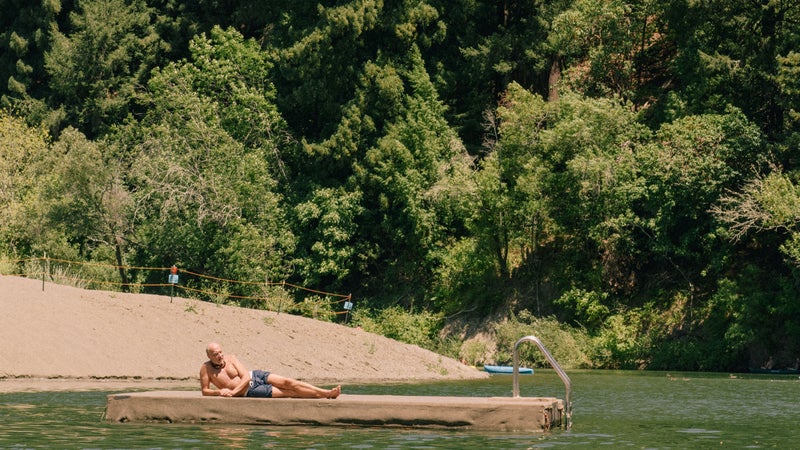
Last year the California State Lands Commission issued a report declaring that the area up to O’Flynn’s grass lies below the ordinary high-water mark and therefore is public-trust land. Harreld was right: nobody can block the public from enjoying the river. The bench barricade, ironically, had already been swept away by high water during winter flooding.
Triumphant after the ruling, Harreld spoke of O’Flynn with a new note of grace. He was sympathetic about finding a solution to the litter problem. And regarding the security cameras, he suggested using them to prosecute anyone who might pollute the beach, rather than to deter people from going there in the first place. “I would 100 percent support this,” Harreld said. O’Flynn still declines to speak in detail about the case.
As of this writing, a new sign, lovingly handmade, stands by the water: HELP RESTORE THE RIPARIAN COORIDOR—PLEASE LAUNCH WATERCRAFT UP RIVER.
Update: (November 6, 2020) Two years after this story was published, the California State Lands Commission changed its determination of the ordinary high-water mark. It now rests below the beach in question, meaning the beach is not currently considered public-trust land. A representative from the Commission emphasized that these marks are ambulatory and subject to move in the future.




